Monday, 12 July 2010: Ghent: Let the meetings begin!
Written 15 July 2010
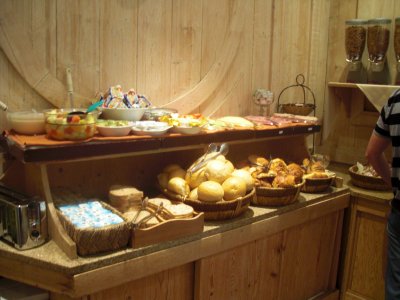 Monday morning, the meetings began in earnest. We had breakfast at the hotel (at 15 euros each) because we had not yet found anywhere else to go. The only restaurants nearby that served breakfast (including "the Noose," where we had supper last night) only opened at 9 a.m., too late for our purposes. Not even that good a breakfast—spherical "hard rolls" (very fluffy and insubstantial inside), pastries (not very good; the pains au chocolate were spoiled by a sugary frosting on top, and the croissants were stale). They did have excellent whole-milk yogurt and "quark" and some very good salami, but the hot drinks were dispensed by a machine; the chocolate was okay, but no decaf was available. The best combination I found was a sort of apple-pear butter (provided in little sealed, single-serve cups) that was absolutely outstanding with the yogurt.
Monday morning, the meetings began in earnest. We had breakfast at the hotel (at 15 euros each) because we had not yet found anywhere else to go. The only restaurants nearby that served breakfast (including "the Noose," where we had supper last night) only opened at 9 a.m., too late for our purposes. Not even that good a breakfast—spherical "hard rolls" (very fluffy and insubstantial inside), pastries (not very good; the pains au chocolate were spoiled by a sugary frosting on top, and the croissants were stale). They did have excellent whole-milk yogurt and "quark" and some very good salami, but the hot drinks were dispensed by a machine; the chocolate was okay, but no decaf was available. The best combination I found was a sort of apple-pear butter (provided in little sealed, single-serve cups) that was absolutely outstanding with the yogurt.
 In the breakfast room, we encountered Michaela Schratzenberger, a young colleague who spent a few months in David's lab during her student days. She has since married a British scientist and settled in London, and they had brought their year-old son Lucas, who was soon David's new best friend. Lucas's favorite game, while we're standing around talking in the lobby between sessions, is to push away from his mother, reaching desperately, meaning "I want to go to David!" As soon has David took him, bounced him a couple of times, and elicited a laugh, it was push, reach, "I want to go to Daddy!" Then, within a few seconds, laugh, push, reach, "I want to go to Mommy!" Sometimes even "I want to go to Anne!" Round and round—hilarious good fun.
In the breakfast room, we encountered Michaela Schratzenberger, a young colleague who spent a few months in David's lab during her student days. She has since married a British scientist and settled in London, and they had brought their year-old son Lucas, who was soon David's new best friend. Lucas's favorite game, while we're standing around talking in the lobby between sessions, is to push away from his mother, reaching desperately, meaning "I want to go to David!" As soon has David took him, bounced him a couple of times, and elicited a laugh, it was push, reach, "I want to go to Daddy!" Then, within a few seconds, laugh, push, reach, "I want to go to Mommy!" Sometimes even "I want to go to Anne!" Round and round—hilarious good fun.
After breakfast, we hiked down the riverbank, then three blocks inland to the Aula. The meetings go very smoothly. So far, quite good acoustics, no audiovisual problems, room just about the right size (and it's easy for people to come and go without causing a disturbance). The only flaws are a paucity of electrical outlets (though not very many of us are using computers during the lectures, so we don't have to take turns); a prohibition on eating and drinking in the auditorium, limiting water consumption to the breaks; and the fact that the auditorium itself is a wifi deadspot, even though wireless is available everywhere else in the building. Many people have complained that the rows of seats are too close together—that their knees hit the seat in front of them—though I have't noticed the problem, and I'm not exactly short.
At breaks, they serve coffee, tea, orange juice, slices of pound cake, and "speculoos" cookies. Water is available ad lib from a table-top cooler, in respectably large plastic cups (an improvement over the situation at receptions, where you must ask for water every time, and they refuse to pour it into anything larger than a wineglass—the large, handsome beer glasses are strictly reserved for their respective brands of beer). The cooler is one of those that have both a "cold" and a "hot" tap, and the temperatures are displayed as digital readouts. Strangely, the difference is rarely more than 10°C, and often more like 4°C. Perhaps we go through the carboys too fast for the heating and cooling elements to come to equilibrium.

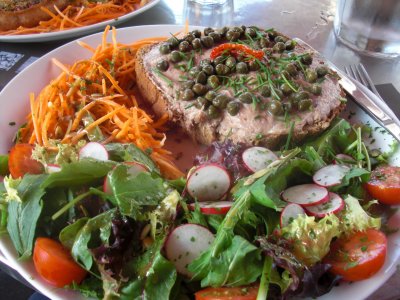 Monday at lunchtime, we and a few colleagues walked back up to the neighborhood of our hotel for lunch and settled at "Zwarte Zee" ("Black Sea"). David had the quiche of the day (summer vegetable, I think). I chose the "salad with duck rillettes and capers" ("rillettes" is a sort of coarse spreadable pâté of highly seasoned cooked duck meat pulverized and bound with duck fat), which turned out to be a thick slab of whole-grain seed-studded bread thickly spread with duck rillettes and lavishly decorated with a spiral pattern of large, whole capers, fresh chives, and a piece of roasted tomato. Delicious! The salad was also great—the radishes were mild and crisp, and the whole things was thickly sprinkled with assorted crisp roasted seeds (pumpkin, sunflower, pine nuts). I got dessert off the meeting's registration desk, where each day they provide a basket of a different regionally typical candy. That day, they had "cuberons," the conical, red candies I had seen in show windows in Brussels. The outer shell is sort of like a raspberry gumdrop, but the center is an almost liquid gel of black raspberry. Excellent.
Monday at lunchtime, we and a few colleagues walked back up to the neighborhood of our hotel for lunch and settled at "Zwarte Zee" ("Black Sea"). David had the quiche of the day (summer vegetable, I think). I chose the "salad with duck rillettes and capers" ("rillettes" is a sort of coarse spreadable pâté of highly seasoned cooked duck meat pulverized and bound with duck fat), which turned out to be a thick slab of whole-grain seed-studded bread thickly spread with duck rillettes and lavishly decorated with a spiral pattern of large, whole capers, fresh chives, and a piece of roasted tomato. Delicious! The salad was also great—the radishes were mild and crisp, and the whole things was thickly sprinkled with assorted crisp roasted seeds (pumpkin, sunflower, pine nuts). I got dessert off the meeting's registration desk, where each day they provide a basket of a different regionally typical candy. That day, they had "cuberons," the conical, red candies I had seen in show windows in Brussels. The outer shell is sort of like a raspberry gumdrop, but the center is an almost liquid gel of black raspberry. Excellent.
 The last half of the afternoon session was devoted to a tribute to colleague Carlo Heip—he was one of the hosts of the meeting when the meiobenthologists met here in 1983 and has been active in the field for 40 years. He was presented with a bound volume of his own work on meiofauna—333 papers, written with various combinations of 500 different collaborators! Only a single bound volume was produced, but the entire contents was made available free of charge on CD-ROM to everyone attending the meeting. The presentation was followed by a reception in Carlo's honor, where once again, beer, wine, OJ, and water were provided ad lib, and hot and cold hors d'oeuvres were passed (ceramic Asian spoons with, e.g., chunks of smoked salmon with mustard sauce or sweetened goat cheese with lavender flowers, small glasses of quinoa tabouleh or shrimp salad). We weren't sure whether the hors d'oeuvres would be heavy enough to constitute dinner, so we elected to leave early, so as to get a sandwich or some such before returning for the evening's scheduled boat tour of Ghent. Of course, we were waylaid by young Lucas in the lobby and spent some time playing the "I want to go to . . ." game, so by the time we set off for the hotel, time was running short. David decided his feet hurt, and he preferred to skip the boat tour, so I dropped off my computer gear at the hotel and picked up a little take-out sushi (the only take-out food I found along the ; one piece each egg, salmon, and tuna, plus three smaller pieces with different vegetable pickles) on the way back to the Aula. While I went on the tour, David dined on pasta carbonara at a place near the hotel (not having studied Flemish food terms in advance, he chose an Italian restaurant, where he could read the menu).
The last half of the afternoon session was devoted to a tribute to colleague Carlo Heip—he was one of the hosts of the meeting when the meiobenthologists met here in 1983 and has been active in the field for 40 years. He was presented with a bound volume of his own work on meiofauna—333 papers, written with various combinations of 500 different collaborators! Only a single bound volume was produced, but the entire contents was made available free of charge on CD-ROM to everyone attending the meeting. The presentation was followed by a reception in Carlo's honor, where once again, beer, wine, OJ, and water were provided ad lib, and hot and cold hors d'oeuvres were passed (ceramic Asian spoons with, e.g., chunks of smoked salmon with mustard sauce or sweetened goat cheese with lavender flowers, small glasses of quinoa tabouleh or shrimp salad). We weren't sure whether the hors d'oeuvres would be heavy enough to constitute dinner, so we elected to leave early, so as to get a sandwich or some such before returning for the evening's scheduled boat tour of Ghent. Of course, we were waylaid by young Lucas in the lobby and spent some time playing the "I want to go to . . ." game, so by the time we set off for the hotel, time was running short. David decided his feet hurt, and he preferred to skip the boat tour, so I dropped off my computer gear at the hotel and picked up a little take-out sushi (the only take-out food I found along the ; one piece each egg, salmon, and tuna, plus three smaller pieces with different vegetable pickles) on the way back to the Aula. While I went on the tour, David dined on pasta carbonara at a place near the hotel (not having studied Flemish food terms in advance, he chose an Italian restaurant, where he could read the menu).
When I got back to the Aula, after the official end of the reception, and only a few minutes before departure for the tour, hors d'oeuvres were still being passed. I saw unfamiliar glasses being cleared away (some other sort of food), spotted a half-eaten miniature crême brulée (but couldn't find an intact one), and found a tray of small sandwiches, from which I got quite a good four-inch oval bun filled with chicken, lettuce, tomato, and mayo. Other sandwiches seemed to replace the chicken with slices of cheese (vegetarian options are always offered taken). Clearly, we could have stayed and eaten hors d'oeurves of increasing substantiality for two and a half hours!
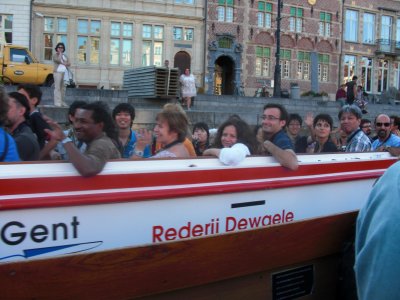
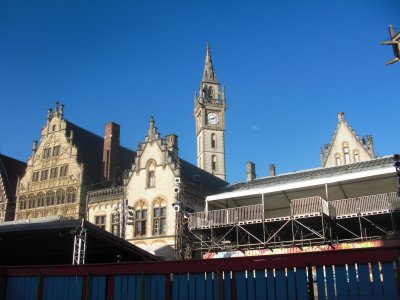 Promptly at 7:30 p.m., we left in a long, straggling column (following, in good tour-group fashion, a guide carrying one of the blue FourtIMCo umbrellas we were issued at registration) for the "grain harbor," the wide spot in the river just below its confluence with the canal (epicenter of Ghent tourist territory), where they loaded us onto a series of these low boats (fortunately, the rain feared by the organizers held off) for the 40-minute tour. Shown here are our colleagues in the second boat, which we in the first boat passed on several occasions. Much of the waterfront architecture is actually 20th century but was built, on the occasion of the Brussels world's fair, to look medieval. Note the clock tower, clearly inspired by London's Big Ben.
Promptly at 7:30 p.m., we left in a long, straggling column (following, in good tour-group fashion, a guide carrying one of the blue FourtIMCo umbrellas we were issued at registration) for the "grain harbor," the wide spot in the river just below its confluence with the canal (epicenter of Ghent tourist territory), where they loaded us onto a series of these low boats (fortunately, the rain feared by the organizers held off) for the 40-minute tour. Shown here are our colleagues in the second boat, which we in the first boat passed on several occasions. Much of the waterfront architecture is actually 20th century but was built, on the occasion of the Brussels world's fair, to look medieval. Note the clock tower, clearly inspired by London's Big Ben.
The tour started with a short trip upstream to look at the massive brewers' church and the brewer's guild hall (now a Marriott hotel; the lovely old façade has been preserved, with its pair of gilded swans—one swan is the sign of beer, two the sign of a brothel—but inside, its lobby is a huge glass-topped atrium, visible from above, e.g., from the top of the castle). Just now, much of the waterfront is obscured from the boat tours by the all the temperary structures (stages, grandstands, bars, restaurant pavilions) set up for the Saturday-afternoon kick-off of the huge Ghent festival.
We then turned around (passing the boat behind), bore right at the confluence, and (on the second leg) cruised along the river in the other direction, past the huge "meat hall" (the city's meat market) on one side and the huge "fish market" (brand new, to open in November) on the other. Tied up on either side of the river at this stage are a series of beautiful, ornate hand-made wooden boats, sort of like gondolas but all different, which were apparently made, as a hobby, by the proprietor of a local Turkish restaurant.
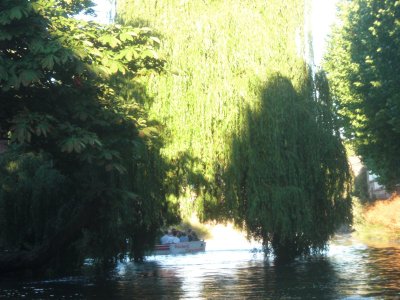
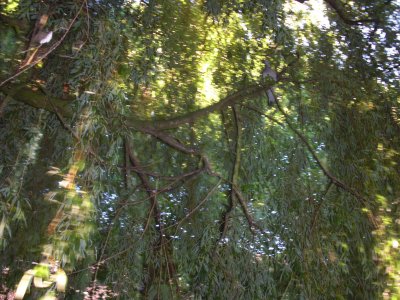 After another U-turn, we cruised up the left branch of the confluence, the canal to Bruges. On the way, we passed under this huge weeping willow, which I photographed both as we approached (left) and from underneath (right). In the latter, I caught a Eurasian collared dove (upper right quadrant), which I didn't even notice was there at the time.
After another U-turn, we cruised up the left branch of the confluence, the canal to Bruges. On the way, we passed under this huge weeping willow, which I photographed both as we approached (left) and from underneath (right). In the latter, I caught a Eurasian collared dove (upper right quadrant), which I didn't even notice was there at the time.
Along the way, the guide pointed out a small "manneken pis" over the doorway of a building that, originally, was a tannery. Apparently, the small pissing boy is the symbol of a tannery—urine was used in the tanning process, so all the boys in the city were always invited to relieve themselves at the tanneries (I don't know whether payment or other inducements were offered). The "manneken pis" in Brussels is only the most famous; chocolate shops all over Belgium (but particular in Brussels) make chocolate replicas of him, in two "life sizes"—life size in the sense of being the size of the real statue and, slightly larger, life size in the sense of being the size of a real boy. Many shops also offer considerably more risqué shapes.

 Theoretically, we could have cruised the canal all the way to Bruges, which at the time it was dug (by means of 17 years of hand labor) meant all the way to the sea. The merchanges of Ghent already had a route to the sea, via the river, but that meant passing through Antwerp and paying that city's heavy tolls, so they built the canal to by-pass that inconvenience. Nowadays, the full length of the canal is apparently no longer navigable. Along the way, we passed under the "bridge of pleasures," the four posts of which depict four pleasures of Charles Quint ("Kaiser Karel"; who was Duke of Braband, 1515-1555, as Charles II; king of Spain and Spanish America as Carlos I; king of Sicily, 1516-1556, as Charles IV; and emporer of the germanic Holy Roman Empire, 1519-1556, as Charles V or Karl V). These two posts represent horse-back riding and some other one (serving the church?). At the last remaining gate in the wall that once encircled the city (right), we turnd around again.
Theoretically, we could have cruised the canal all the way to Bruges, which at the time it was dug (by means of 17 years of hand labor) meant all the way to the sea. The merchanges of Ghent already had a route to the sea, via the river, but that meant passing through Antwerp and paying that city's heavy tolls, so they built the canal to by-pass that inconvenience. Nowadays, the full length of the canal is apparently no longer navigable. Along the way, we passed under the "bridge of pleasures," the four posts of which depict four pleasures of Charles Quint ("Kaiser Karel"; who was Duke of Braband, 1515-1555, as Charles II; king of Spain and Spanish America as Carlos I; king of Sicily, 1516-1556, as Charles IV; and emporer of the germanic Holy Roman Empire, 1519-1556, as Charles V or Karl V). These two posts represent horse-back riding and some other one (serving the church?). At the last remaining gate in the wall that once encircled the city (right), we turnd around again.

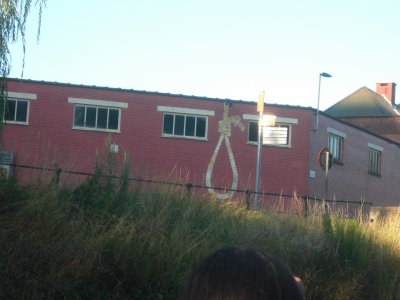 Charles was born (in 1500) and raised in Ghent, in a palace along this canal (his ancestors had decided, a couple of generations before, that the castle was too cold, damp, dark, and uncomfortable). The palace is gone, demolished to make way for textile mills shortly after the industrial revolution, but one of the buildings was decorated with this stylized portrait of Charles. Another was decorated with a hangman's noose. The tour guide finally explained the noose. At some point in history, the burghers refused to pay their taxes, so their leaders were forced to walk barefoot through the city, dressed in white shifts and wearing nooses around their necks, to apologize to to the count. For some reason, the residents have been proud of this episode every since (perhaps they still refused to pay their taxes) and have ever since been nicknamed "rope-carriers," because of the nooses. A statue along the canal commemorates the event. So I guess the name of our first-night restaurant has nothing to do torture after all.—"T' Stropkes" just means "rope-carriers," i.e., proud Ghentians.
Charles was born (in 1500) and raised in Ghent, in a palace along this canal (his ancestors had decided, a couple of generations before, that the castle was too cold, damp, dark, and uncomfortable). The palace is gone, demolished to make way for textile mills shortly after the industrial revolution, but one of the buildings was decorated with this stylized portrait of Charles. Another was decorated with a hangman's noose. The tour guide finally explained the noose. At some point in history, the burghers refused to pay their taxes, so their leaders were forced to walk barefoot through the city, dressed in white shifts and wearing nooses around their necks, to apologize to to the count. For some reason, the residents have been proud of this episode every since (perhaps they still refused to pay their taxes) and have ever since been nicknamed "rope-carriers," because of the nooses. A statue along the canal commemorates the event. So I guess the name of our first-night restaurant has nothing to do torture after all.—"T' Stropkes" just means "rope-carriers," i.e., proud Ghentians.

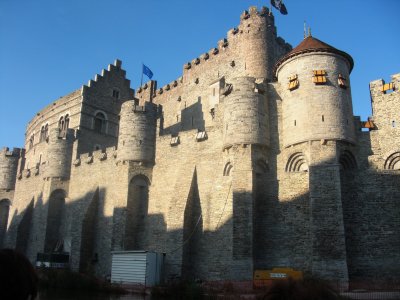 Finally, back at the confluence, we got these great views of the castle, "Grafensteen" ("Graf" means "Count"; it's the castle of the counts of Flanders). It was extensively restored in the 19th centure, when the crenelations were added, to make it more castle-like. It now houses museums of weapons and of instruments of torture.
Finally, back at the confluence, we got these great views of the castle, "Grafensteen" ("Graf" means "Count"; it's the castle of the counts of Flanders). It was extensively restored in the 19th centure, when the crenelations were added, to make it more castle-like. It now houses museums of weapons and of instruments of torture.
During the tour, the guide explained several other phenomena. The main wine harbor was up the canal a ways from the city center, so that the boats could unload and sell their wares outside the city (i.e., without paying city tolls). The boats are all so small and low so that they can pass under the very low bridges every few hundred yards. Most of the bridges are "swing bridges," meaning they can be swung sideways out of the way to taller ships pass, but they are seldom moved now, because traffic across the bridges is much more important than shipping. Although we could see a certain amoung of trash (empty plastic bottles, leaf litter) floating on the canals, the guide assured us that the water is actually quite clean. Fishes once absent because of pollution have since returned and are abundant in the canals and river.
Finally, we learned that the industrial revolution on the European continent began in Ghent. A local merchant traveled to England, studied the workings of spinning and weaving mills for a couple of years, then actually stole a set of spinning and weaving machinery and brought it back to Ghent, where it was copied. Ghent therefore because the center of an ever growing and expanding industrial textile trade, now largely gone.
previous entry
List of Entries
next entry
 Monday morning, the meetings began in earnest. We had breakfast at the hotel (at 15 euros each) because we had not yet found anywhere else to go. The only restaurants nearby that served breakfast (including "the Noose," where we had supper last night) only opened at 9 a.m., too late for our purposes. Not even that good a breakfast—spherical "hard rolls" (very fluffy and insubstantial inside), pastries (not very good; the pains au chocolate were spoiled by a sugary frosting on top, and the croissants were stale). They did have excellent whole-milk yogurt and "quark" and some very good salami, but the hot drinks were dispensed by a machine; the chocolate was okay, but no decaf was available. The best combination I found was a sort of apple-pear butter (provided in little sealed, single-serve cups) that was absolutely outstanding with the yogurt.
Monday morning, the meetings began in earnest. We had breakfast at the hotel (at 15 euros each) because we had not yet found anywhere else to go. The only restaurants nearby that served breakfast (including "the Noose," where we had supper last night) only opened at 9 a.m., too late for our purposes. Not even that good a breakfast—spherical "hard rolls" (very fluffy and insubstantial inside), pastries (not very good; the pains au chocolate were spoiled by a sugary frosting on top, and the croissants were stale). They did have excellent whole-milk yogurt and "quark" and some very good salami, but the hot drinks were dispensed by a machine; the chocolate was okay, but no decaf was available. The best combination I found was a sort of apple-pear butter (provided in little sealed, single-serve cups) that was absolutely outstanding with the yogurt. In the breakfast room, we encountered Michaela Schratzenberger, a young colleague who spent a few months in David's lab during her student days. She has since married a British scientist and settled in London, and they had brought their year-old son Lucas, who was soon David's new best friend. Lucas's favorite game, while we're standing around talking in the lobby between sessions, is to push away from his mother, reaching desperately, meaning "I want to go to David!" As soon has David took him, bounced him a couple of times, and elicited a laugh, it was push, reach, "I want to go to Daddy!" Then, within a few seconds, laugh, push, reach, "I want to go to Mommy!" Sometimes even "I want to go to Anne!" Round and round—hilarious good fun.
In the breakfast room, we encountered Michaela Schratzenberger, a young colleague who spent a few months in David's lab during her student days. She has since married a British scientist and settled in London, and they had brought their year-old son Lucas, who was soon David's new best friend. Lucas's favorite game, while we're standing around talking in the lobby between sessions, is to push away from his mother, reaching desperately, meaning "I want to go to David!" As soon has David took him, bounced him a couple of times, and elicited a laugh, it was push, reach, "I want to go to Daddy!" Then, within a few seconds, laugh, push, reach, "I want to go to Mommy!" Sometimes even "I want to go to Anne!" Round and round—hilarious good fun.
 Monday at lunchtime, we and a few colleagues walked back up to the neighborhood of our hotel for lunch and settled at "Zwarte Zee" ("Black Sea"). David had the quiche of the day (summer vegetable, I think). I chose the "salad with duck rillettes and capers" ("rillettes" is a sort of coarse spreadable pâté of highly seasoned cooked duck meat pulverized and bound with duck fat), which turned out to be a thick slab of whole-grain seed-studded bread thickly spread with duck rillettes and lavishly decorated with a spiral pattern of large, whole capers, fresh chives, and a piece of roasted tomato. Delicious! The salad was also great—the radishes were mild and crisp, and the whole things was thickly sprinkled with assorted crisp roasted seeds (pumpkin, sunflower, pine nuts). I got dessert off the meeting's registration desk, where each day they provide a basket of a different regionally typical candy. That day, they had "cuberons," the conical, red candies I had seen in show windows in Brussels. The outer shell is sort of like a raspberry gumdrop, but the center is an almost liquid gel of black raspberry. Excellent.
Monday at lunchtime, we and a few colleagues walked back up to the neighborhood of our hotel for lunch and settled at "Zwarte Zee" ("Black Sea"). David had the quiche of the day (summer vegetable, I think). I chose the "salad with duck rillettes and capers" ("rillettes" is a sort of coarse spreadable pâté of highly seasoned cooked duck meat pulverized and bound with duck fat), which turned out to be a thick slab of whole-grain seed-studded bread thickly spread with duck rillettes and lavishly decorated with a spiral pattern of large, whole capers, fresh chives, and a piece of roasted tomato. Delicious! The salad was also great—the radishes were mild and crisp, and the whole things was thickly sprinkled with assorted crisp roasted seeds (pumpkin, sunflower, pine nuts). I got dessert off the meeting's registration desk, where each day they provide a basket of a different regionally typical candy. That day, they had "cuberons," the conical, red candies I had seen in show windows in Brussels. The outer shell is sort of like a raspberry gumdrop, but the center is an almost liquid gel of black raspberry. Excellent. The last half of the afternoon session was devoted to a tribute to colleague Carlo Heip—he was one of the hosts of the meeting when the meiobenthologists met here in 1983 and has been active in the field for 40 years. He was presented with a bound volume of his own work on meiofauna—333 papers, written with various combinations of 500 different collaborators! Only a single bound volume was produced, but the entire contents was made available free of charge on CD-ROM to everyone attending the meeting. The presentation was followed by a reception in Carlo's honor, where once again, beer, wine, OJ, and water were provided ad lib, and hot and cold hors d'oeuvres were passed (ceramic Asian spoons with, e.g., chunks of smoked salmon with mustard sauce or sweetened goat cheese with lavender flowers, small glasses of quinoa tabouleh or shrimp salad). We weren't sure whether the hors d'oeuvres would be heavy enough to constitute dinner, so we elected to leave early, so as to get a sandwich or some such before returning for the evening's scheduled boat tour of Ghent. Of course, we were waylaid by young Lucas in the lobby and spent some time playing the "I want to go to . . ." game, so by the time we set off for the hotel, time was running short. David decided his feet hurt, and he preferred to skip the boat tour, so I dropped off my computer gear at the hotel and picked up a little take-out sushi (the only take-out food I found along the ; one piece each egg, salmon, and tuna, plus three smaller pieces with different vegetable pickles) on the way back to the Aula. While I went on the tour, David dined on pasta carbonara at a place near the hotel (not having studied Flemish food terms in advance, he chose an Italian restaurant, where he could read the menu).
The last half of the afternoon session was devoted to a tribute to colleague Carlo Heip—he was one of the hosts of the meeting when the meiobenthologists met here in 1983 and has been active in the field for 40 years. He was presented with a bound volume of his own work on meiofauna—333 papers, written with various combinations of 500 different collaborators! Only a single bound volume was produced, but the entire contents was made available free of charge on CD-ROM to everyone attending the meeting. The presentation was followed by a reception in Carlo's honor, where once again, beer, wine, OJ, and water were provided ad lib, and hot and cold hors d'oeuvres were passed (ceramic Asian spoons with, e.g., chunks of smoked salmon with mustard sauce or sweetened goat cheese with lavender flowers, small glasses of quinoa tabouleh or shrimp salad). We weren't sure whether the hors d'oeuvres would be heavy enough to constitute dinner, so we elected to leave early, so as to get a sandwich or some such before returning for the evening's scheduled boat tour of Ghent. Of course, we were waylaid by young Lucas in the lobby and spent some time playing the "I want to go to . . ." game, so by the time we set off for the hotel, time was running short. David decided his feet hurt, and he preferred to skip the boat tour, so I dropped off my computer gear at the hotel and picked up a little take-out sushi (the only take-out food I found along the ; one piece each egg, salmon, and tuna, plus three smaller pieces with different vegetable pickles) on the way back to the Aula. While I went on the tour, David dined on pasta carbonara at a place near the hotel (not having studied Flemish food terms in advance, he chose an Italian restaurant, where he could read the menu).
 Promptly at 7:30 p.m., we left in a long, straggling column (following, in good tour-group fashion, a guide carrying one of the blue FourtIMCo umbrellas we were issued at registration) for the "grain harbor," the wide spot in the river just below its confluence with the canal (epicenter of Ghent tourist territory), where they loaded us onto a series of these low boats (fortunately, the rain feared by the organizers held off) for the 40-minute tour. Shown here are our colleagues in the second boat, which we in the first boat passed on several occasions. Much of the waterfront architecture is actually 20th century but was built, on the occasion of the Brussels world's fair, to look medieval. Note the clock tower, clearly inspired by London's Big Ben.
Promptly at 7:30 p.m., we left in a long, straggling column (following, in good tour-group fashion, a guide carrying one of the blue FourtIMCo umbrellas we were issued at registration) for the "grain harbor," the wide spot in the river just below its confluence with the canal (epicenter of Ghent tourist territory), where they loaded us onto a series of these low boats (fortunately, the rain feared by the organizers held off) for the 40-minute tour. Shown here are our colleagues in the second boat, which we in the first boat passed on several occasions. Much of the waterfront architecture is actually 20th century but was built, on the occasion of the Brussels world's fair, to look medieval. Note the clock tower, clearly inspired by London's Big Ben.
 After another U-turn, we cruised up the left branch of the confluence, the canal to Bruges. On the way, we passed under this huge weeping willow, which I photographed both as we approached (left) and from underneath (right). In the latter, I caught a Eurasian collared dove (upper right quadrant), which I didn't even notice was there at the time.
After another U-turn, we cruised up the left branch of the confluence, the canal to Bruges. On the way, we passed under this huge weeping willow, which I photographed both as we approached (left) and from underneath (right). In the latter, I caught a Eurasian collared dove (upper right quadrant), which I didn't even notice was there at the time. 
 Theoretically, we could have cruised the canal all the way to Bruges, which at the time it was dug (by means of 17 years of hand labor) meant all the way to the sea. The merchanges of Ghent already had a route to the sea, via the river, but that meant passing through Antwerp and paying that city's heavy tolls, so they built the canal to by-pass that inconvenience. Nowadays, the full length of the canal is apparently no longer navigable. Along the way, we passed under the "bridge of pleasures," the four posts of which depict four pleasures of Charles Quint ("Kaiser Karel"; who was Duke of Braband, 1515-1555, as Charles II; king of Spain and Spanish America as Carlos I; king of Sicily, 1516-1556, as Charles IV; and emporer of the germanic Holy Roman Empire, 1519-1556, as Charles V or Karl V). These two posts represent horse-back riding and some other one (serving the church?). At the last remaining gate in the wall that once encircled the city (right), we turnd around again.
Theoretically, we could have cruised the canal all the way to Bruges, which at the time it was dug (by means of 17 years of hand labor) meant all the way to the sea. The merchanges of Ghent already had a route to the sea, via the river, but that meant passing through Antwerp and paying that city's heavy tolls, so they built the canal to by-pass that inconvenience. Nowadays, the full length of the canal is apparently no longer navigable. Along the way, we passed under the "bridge of pleasures," the four posts of which depict four pleasures of Charles Quint ("Kaiser Karel"; who was Duke of Braband, 1515-1555, as Charles II; king of Spain and Spanish America as Carlos I; king of Sicily, 1516-1556, as Charles IV; and emporer of the germanic Holy Roman Empire, 1519-1556, as Charles V or Karl V). These two posts represent horse-back riding and some other one (serving the church?). At the last remaining gate in the wall that once encircled the city (right), we turnd around again.
 Charles was born (in 1500) and raised in Ghent, in a palace along this canal (his ancestors had decided, a couple of generations before, that the castle was too cold, damp, dark, and uncomfortable). The palace is gone, demolished to make way for textile mills shortly after the industrial revolution, but one of the buildings was decorated with this stylized portrait of Charles. Another was decorated with a hangman's noose. The tour guide finally explained the noose. At some point in history, the burghers refused to pay their taxes, so their leaders were forced to walk barefoot through the city, dressed in white shifts and wearing nooses around their necks, to apologize to to the count. For some reason, the residents have been proud of this episode every since (perhaps they still refused to pay their taxes) and have ever since been nicknamed "rope-carriers," because of the nooses. A statue along the canal commemorates the event. So I guess the name of our first-night restaurant has nothing to do torture after all.—"T' Stropkes" just means "rope-carriers," i.e., proud Ghentians.
Charles was born (in 1500) and raised in Ghent, in a palace along this canal (his ancestors had decided, a couple of generations before, that the castle was too cold, damp, dark, and uncomfortable). The palace is gone, demolished to make way for textile mills shortly after the industrial revolution, but one of the buildings was decorated with this stylized portrait of Charles. Another was decorated with a hangman's noose. The tour guide finally explained the noose. At some point in history, the burghers refused to pay their taxes, so their leaders were forced to walk barefoot through the city, dressed in white shifts and wearing nooses around their necks, to apologize to to the count. For some reason, the residents have been proud of this episode every since (perhaps they still refused to pay their taxes) and have ever since been nicknamed "rope-carriers," because of the nooses. A statue along the canal commemorates the event. So I guess the name of our first-night restaurant has nothing to do torture after all.—"T' Stropkes" just means "rope-carriers," i.e., proud Ghentians.
 Finally, back at the confluence, we got these great views of the castle, "Grafensteen" ("Graf" means "Count"; it's the castle of the counts of Flanders). It was extensively restored in the 19th centure, when the crenelations were added, to make it more castle-like. It now houses museums of weapons and of instruments of torture.
Finally, back at the confluence, we got these great views of the castle, "Grafensteen" ("Graf" means "Count"; it's the castle of the counts of Flanders). It was extensively restored in the 19th centure, when the crenelations were added, to make it more castle-like. It now houses museums of weapons and of instruments of torture.